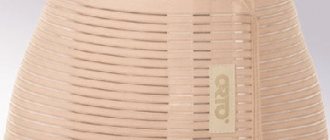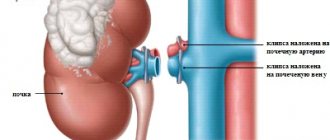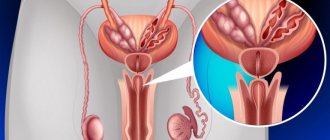“Wet” problems of women: how to rid yourself of unpleasant symptoms?
Table of contents:
Urinary incontinence is more common in women than in men. This is due to the anatomical features of the body and the functioning of peripheral organs. Urine may leak due to weakening of the muscular apparatus of the bladder and sphincters, as well as in connection with pregnancy, childbirth, or previous surgical interventions. Age also plays an important role in the etiology of the disease. The older a woman is, the more likely “wet swimsuit” syndrome becomes.
Forms of urinary incontinence
- Stress form - urine leaks out involuntarily during slight stress (laughing, sneezing, coughing, lifting heavy objects, etc.). Basically, the woman does not feel the urge to urinate. Sudden increases in intraperitoneal pressure can serve as a stimulating factor for weakened muscular elements of the pelvic floor and urethra, thereby provoking the leakage of urine. Experts also associate muscle weakening and pelvic organ prolapse with the amount of collagen content observed in menopausal women.
- Urgent form - involuntary urination occurs after a strong urge (overactive bladder syndrome). Typically, a woman cannot control the spontaneous leakage of urine and often does not make it to the toilet. Urge incontinence can be provoked by external factors (washing hands, washing dishes, the sound of water, cold season, nervous excitement, etc.).
- Mixed form - characterized by a strong urge to urinate combined with slight tension (change in body position, sneezing, coughing or laughing).
- Enuresis is a form characterized by involuntary release of urine at any time of the day. When bedwetting is noted in women, we are talking about nocturnal enuresis.
- Permanent incontinence is associated with pathology of the urinary tract, abnormal structure of the ureter, sphincter failure, etc.
- Dripping - immediately after urination, a slight dripping of urine occurs, which remains and accumulates in the urethra.
The most common are stress and urgency urinary incontinence; all other forms are rare.
Classification of stress urinary incontinence
- 0 – increased urethral mobility without documented evidence of incontinence;
- I - increased urethral mobility with documentary confirmation during physical examination;
- II – similar to type I with the formation of a cystocele;
- IIa – cystocele in the vagina;
- IIb – cystocele outside the vagina;
- III - internal urethral insufficiency (proximal sphincter), severe urinary incontinence.
Causes of spontaneous urine loss
Before naming the causes of the pathology, you should understand the physiology of urinary function. The entire urinary cycle can be divided into two phases: filling the bladder and releasing urine. During the period of filling the urea, all urine accumulates, as in a reservoir. At this time, the sphincter is in a contracted state and prevents the release of drops of urine. During the act of urination, complete relaxation of the sphincters occurs. This process promotes easy and free flow of urine, which can also be interrupted arbitrarily. Given this fact, urinary incontinence is mainly due to dysfunction of the sphincters.
In addition, there are the following causes of involuntary urination:
- Prolapse of the vaginal walls;
- Prolapse and prolapse of the uterus;
- Rapid or prolonged labor;
- Gynecological interventions (removal of tumors, hysterectomy, etc.);
- Perineal injuries;
- Inflammation of the female genital organs;
- Endourethral surgeries;
- Bladder tumors;
- Chronic processes of the genitourinary system (urinary incontinence due to cystitis);
- Injuries and diseases of the spine.
Diagnostics
Treatment of female urinary incontinence should begin after a competent and objective examination. To make a correct diagnosis, you must go through the following steps:
- Anamnesis collection. The stage includes a survey of the woman, during which the urologist collects information about the number of births, the nature of their duration, the presence of surgical intervention on the pelvic organs, as well as concomitant somatic diseases
- Vaginal examination, smear collection
- Taking a general urine test, bacteriological and cytological examination
- Ultrasound examination of the kidneys and bladder
- Urodynamic study:
- Uroflowmetry (urination indicator);
- Cystometry (an indicator of pressure in the bladder when completely filled using a catheter);
- Profilometry (determination of pressure in the urethra);
- Electromyography (measurement of the contractile function of the perineal muscles);
- Keeping a diary of urine output.
Female urinary system
Symptoms of urinary incontinence in women significantly impair normal life. Representatives of the fairer sex have to constantly look for a toilet, so they avoid long trips, concerts or other events. In some cases, urinary incontinence can also affect intimate relationships.
ADVICE: Do not hide the pathology and do not deceive yourself that everything will go away on its own! The earlier the disease is diagnosed, the sooner you can return to a full life, including your personal life!
Often specialists have to deal with the problem of urinary incontinence in women after hysterectomy. Hysterectomy is a major surgical procedure, after which urodynamic disturbances are observed in most women. This is due to hormonal changes in the body and a sharp decrease in the level of female sex hormones. The same thing happens during menopause. Many women experience urinary incontinence during menopause and menopause. However, pathology at this age should not be taken as a death sentence. The problem can be treated and the number of years can only influence the choice of treatment tactics.
Conservative treatment of urinary incontinence
Depending on the results of studies and analyses, specialists prescribe a course of treatment, which may include therapeutic measures. This complex includes:
- Kegel exercises (pelvic floor muscle training);
- Correction of hormonal levels;
- Weight stabilization;
- Treatment of chronic pathologies (constipation, diseases of the respiratory system, etc.);
- Physiotherapeutic treatment.
IMPORTANT! Often conservative measures are enough to cope with unpleasant symptoms and begin to control involuntary urination. However, exercise or incontinence pills may not always be a panacea. In the case of stress type incontinence, there is a structural defect in the musculofascial apparatus of the pelvic floor, so surgery may be inevitable.
Operative methods
Today we can say that the variety of surgical treatment methods does not leave a single chance for the disease. Most of them are minimally invasive and gentle, which makes it possible to get rid of the pathology almost painlessly.
1. Introduction of gels and other bulk-forming substances into the submucosal layer of the urethra
The technique consists in narrowing the lumen of the urethra using peculiar “pillows”, with the help of which urine is retained. The operation is quick and captivating in its simplicity. The manipulation is performed under local anesthesia using a cystoscope without a single incision.
2. Anterior plastic surgery (colporrhaphy) – the most common operation
During the intervention, a midline vaginal incision is made and tissue dissection is performed in lateral directions. The tissues are then collected and tightened using a special suture material. A kind of support is created for the urethra, which holds urine. Despite its prevalence, colporrhaphy has narrow indications and a number of complications.
3. Colposuspension according to Birch
The intervention consists of suspending tissue around the urethra and fixing it to the inguinal ligaments. The operation is performed through abdominal access - open or laparoscopic. This method is considered effective in cases of stress urinary incontinence. The main disadvantage of the intervention is general anesthesia and the dependence of the result on the qualifications of the doctor.
4. Sling surgery (implant installation)
The method is modern and effective in 85-90% of cases. During the operation, prosthetics of the damaged fascial urogenital apparatus is performed with a synthetic implant, which grows with its own tissues and becomes a supporting mechanism with increased intra-abdominal pressure. During implantation, the woman is conscious, and an incision is made in the vaginal wall.
conclusions
Urinary incontinence is a problem that has many effective and safe solutions. You shouldn’t give up a decent life and experience the stress of endless unpleasant symptoms. A variety of treatment methods today gives every woman a chance to be complete in every sense of the word.
lechim-pochki.ru
Treatment of bladder dysfunction
Many women experience urinary incontinence during menopause and menopause. Removal of the uterus is a serious gynecological operation that can have a negative impact on the condition of the bladder and cause disturbances in its functioning. Urinary incontinence after removal of the uterus develops because the ligamentous apparatus common to the bladder is damaged (it was previously held by the uterus).
This type of bladder dysfunction is accompanied by frequent urge to go to the toilet, which does not lead to the expected result. A woman may feel an irresistible urge to go to the toilet several times an hour, but urination never occurs. This type of dysfunction is characterized by the fact that after a hysterectomy, most bladder functions are restored, but some may still be impaired.
To restore the tone of the bladder after removal of the uterus, therapeutic exercises, in particular Kegel exercises, are very useful. My friend had this operation when she was found to have multiple fibroids, which were growing very quickly in size and bleeding.
This could be uterine fibroids, malignant neoplasms, polyps, endometriosis, adenomyosis, etc. Thus, American doctors admit that in one hundred cases of hysterectomy, ninety women could save the organ and be treated in other ways. The uterus is a unique organ in which new life can fully develop.
Most often this is pollakiuria - frequent urination both during the day and at night. When straining, urine may not be retained at all, and sometimes it may constantly leak. In this case, women are forced to use special pads.
Hysterectomy also has a negative impact on a woman’s sex life. This is due to a decrease in estrogen and testosterone levels. Research confirms that women who have had their uterus removed are five times more likely to suffer from hypertension than those who have not had the operation.
I read your article and I fundamentally disagree with you. According to your description, after the operation you can continue to live undead. With your article you are developing an inferiority complex in women. When a woman is psychologically prepared, she is relaxed and has the belief that she will certainly get better after a certain time. Her mood is her health.
They know how to support... After all, there are also very suspicious women. They could have reassured us and diluted the article with some positive aspects. There are methods of effective treatment without removing the uterus. You are not experts, that's why you reason like that. But even after removal of the uterus, the consequences can be minimized if the postoperative period is managed correctly and complications are prevented. I also had my uterus and one ovary removed 8 months ago.
Yeah... After reading such an article, you can really fall into depression BEFORE the operation is performed. My hysterectomy is coming soon. Myoma is multinodular for 9-10 weeks, heavy periods for 9-11 days and the cycle has become unclear, and in the middle of the cycle they can start again. I really hope for the “golden hands” of this doctor. It’s probably important to believe in a miracle and live fully and not despair.
Urinary incontinence after hysterectomy - what to do?
Often a woman undergoes a hysterectomy. The consequences of hysterectomy are presented:
- Development of the inflammatory process in the area of the postoperative scar.
- Bleeding.
- Pulmonary embolism (PE).
- Loss of the ability to conceive and give birth to a child.
- Inflammation of the peritoneum.
- The appearance of hematomas.
- Development of pain during urination.
- Urinary incontinence.
- Development of adhesive disease.
If a symptom such as urinary incontinence develops, you should seek help from a specialist. At home, a woman should follow the following recommendations:
- Control your own weight.
- Reduce consumption of drinks containing caffeine.
- To refuse from bad habits.
- Try to establish a urination routine.
- Train your pelvic floor muscles.
In addition to these recommendations, a woman should prevent the development of diseases of the genitourinary and respiratory systems.
Attention! The information on the site is presented by specialists, but is for informational purposes only and cannot be used for independent treatment. Be sure to consult your doctor!
vseoperacii.com (c) 2020 - 2020 - All rights reserved!
vseoperacii.com
Causes of incontinence
The development of the complications described above is associated with the anatomical features of the female body.
The causes of incontinence are:
- Most often, weakening of the ligaments and muscles of the pelvic floor. The muscular-ligamentous apparatus is located in layers, only three layers - the upper (or inner layer, the muscles cover the vagina, urethra and rectum), the middle (the urethra and its sphincter, the vagina are located in it) and the lower (outer, consists of four circular muscles, forming the entrance to the anus and vagina). Urinary incontinence is associated with the muscular-ligamentous apparatus of the middle layer.
- Prolapse of the anterior vaginal wall. Associated with changes in the elasticity of muscles and fascia, due to displacement of the vagina, irritation of the nerve receptors of the bladder occurs.
- Inflammatory processes of the urinary tract. Damage to the bladder mucosa due to the inflammatory component entails false stimulation of the receptors. The urge occurs at the slightest accumulation of urine and can be so strong that it is impossible to control the process.
- Menopausal hormonal changes
The production of estrogen, responsible for tissue elasticity, decreases:
- Weakening of the pelvic floor muscles.
- The elasticity of the bladder decreases and its sensitivity increases.
Urinary incontinence due to diabetes and hysterectomy
Spontaneous, uncontrolled urination is a common occurrence in medicine. Frequent among such cases, doctors call urinary incontinence in diabetes. In addition to this pathology, many other diseases are responsible for such bladder dysfunction. What diseases can lead to urinary incontinence? What diagnostic and treatment methods are used?
Causes of urinary incontinence
Many factors can contribute to the development of uncontrolled urination. Starting from age-related characteristics to serious progressive pathologies. In children, incontinence occurs due to age, since they are not yet able to control physiological needs. The causes of spontaneous urination in adults are mainly various pathologies of the genitourinary system, less often - an advanced form of mental disorders, for example, schizophrenia.
Return to contents
Urinary incontinence in diabetes mellitus
Urinary incontinence in diabetes mellitus is observed even when the disease is severely advanced.
Diabetics are vulnerable to genitourinary infections, which are caused by elevated blood glucose levels. A high glucose ratio, plus its poor uptake by cells, promotes the growth of harmful intermediate binders that interfere with the normal functioning of blood vessels, capillaries and nerves. This worsens the functionality of the genitourinary organs and increases neurogenicity. The nerve fibers are destroyed, after which the performance of the bladder sphincter (the valve at the border of the bladder and the urethra, which controls the flow of urine out) decreases.
Return to contents
When the uterus prolapses
Prolapse of the uterus provokes a frequent urge to urinate.
Uterine prolapse is considered one of the main provocateurs of urinary incontinence in women. The condition manifests itself in the form of a displacement of the uterine body down closer to the vagina. This happens due to weakness of the pelvic muscles and ligaments that hold the uterus. Pathology can be provoked by injuries and congenital defects in this area, severe ruptures of the perineum, the use of obstetric forceps during childbirth, breech presentation and subsequent removal of the baby by the buttocks during the birth process, surgical intervention on the genitals, lack of the hormone estrogen caused by the onset of menopause.
When the uterus prolapses, a woman feels nagging pain and pressure in the lower abdomen. Added to this are disorders of the urinary process:
- frequent urge for small needs;
- feeling that you have not urinated completely;
- difficulty urinating;
- urinary incontinence;
- retention of urine in the bladder.
Return to contents
After hysterectomy
The bladder and uterus are close to each other, respectively connected by the same supporting muscles. The ligaments that hold the uterus in place help the urethra stay in place. However, after removal of the uterus the situation changes. The muscle tissue that holds the bladder weakens, making it difficult for the patient to control urination after surgery and she becomes incontinent.
Return to contents
Urinary incontinence and Parkinson's disease
This problem can occur with Parkinson's disease.
Parkinson's disease is a disorder of the musculoskeletal system, accompanied by limb tremors and paralysis. This disease is a neurological disease, and accordingly affects the nerve tissue of all internal organs, including the bladder. The functional abilities of the bladder begin to malfunction, resulting in difficulty urinating or, conversely, constant uncontrolled urination occurs.
Return to contents
Diagnosis of the disease
In most cases, urinary incontinence is a consequence of a medical condition. Therefore, diagnostics must be carried out comprehensively in order to identify the true cause of what is happening and prescribe the correct treatment. In this case, in addition to interviewing the patient, examining the perineum and monitoring the process of incontinence, doctors resort to radiography, ultrasound of the pelvic organs and kidneys, cystoscopy, prescribe general blood and urine tests, plus additional laboratory tests (for hormones, sugar, bacterial cultures, biochemical studies).
Return to contents
Treatment of pathology
Treatment for urinary incontinence depends on the underlying cause. In the postoperative period during uterine resection, it is necessary to strictly follow the recommendations of the treating doctor. Treatment may involve taking medications or following certain diets. If incontinence is caused by uterine prolapse, Kegel exercises are recommended here. They will strengthen the pelvic muscles and thereby eliminate voluntary urination, plus prevent uterine prolapse. In case of diabetes mellitus, surgical treatment may be necessary.
etopochki.ru
Treatment of the syndrome
Treatment of incontinence in women after removal of the uterus is a long and precise procedure. Any mistake can destroy the results of therapy and even lead to the development of enuresis, cystitis, and infectious and inflammatory processes. Only an integrated approach will ensure complete recovery.
To regulate the urination process and achieve urine retention until the next bowel movement, the doctor may prescribe medication.
To achieve a high therapeutic effect in the treatment of urinary incontinence, pharmacological agents are recommended to be combined with various alternative techniques, as well as physiotherapy: electrical stimulation, diadynamic current, electroiontophoresis with adrenergic blockers.
The optimal solution to support weakened organs of the genitourinary system is a pessary - a silicone device of various shapes and types. It is carefully inserted and placed inside the vagina, securely fastening there. Despite the fact that the device is in the cavity for a long time, the woman does not feel discomfort. According to many patients, the pessary allows you to restore lost tone by stimulating the natural mobility of muscle tissue.
Intimate muscles help the pelvic organs and abdominal cavity function normally. In the absence of the uterus, the topography is disrupted and some of them are displaced. Weakened structures cannot withstand pressure, their condition worsens even more, as a result of which prolapse can develop. Therefore, after a hysterectomy, gymnastics is prescribed according to the Arnold Kegel method - rhythmic tension and relaxation of the muscles of the perineum and abdominal press. Special exercises help achieve the following results:
- improve elasticity and tone muscle tissue;
- strengthen the muscles of the vaginal area;
- restore physical activity;
- get rid of pain and depression.
Taking into account the fact that urinary incontinence is a polyetiological disease, therapy should be aimed, first of all, at eliminating the cause of its development. Therefore, treatment using traditional medicine is not considered a priority for any form of pathology, but performs only an auxiliary function.
On the advice of your doctor, you can use infusions and decoctions of medicinal herbs and their mixtures. No less effective are pharmaceutical herbal infusions, which have anti-inflammatory, antispasmodic and analgesic effects, while simultaneously enriching the woman’s body with vitamins and biologically active elements. Yarrow, dill, sage, St. John's wort, rose hips, and birch buds are considered beneficial. You can drink raw potato juice for 10 days, or drink a millet-based decoction for at least a week.
Exercises after hysterectomy
Some women require complete removal of the uterus as indicated by their doctor. Such surgical intervention is performed exclusively in rare cases when drug and physiotherapeutic treatment has not brought a positive result. The rehabilitation period lasts a long time, so patients are prescribed medications. Women also need to regularly do gymnastics and physical exercises that will help bring muscle tissue to normal condition. Before performing them, you should consult with your doctor, who will give all the necessary recommendations and advice. In most cases, after surgery and removal of the uterus, women face problems such as spontaneous urination and defecation. During surgery, the doctor excises the muscle layer that supports the body of the uterus. In this case, only Kegel gymnastics will help.
Features of hysterectomy
Surgeries to remove the uterus are carried out with resection of muscle tissue and numerous ligaments. The surgical procedure depends on the diagnosis.
Access is achieved by cutting the abdominal wall or several punctures. After surgery, the internal organs located in the pelvis may become displaced. As a result of such exposure, patients face the following problems:
- spontaneous urination;
- constipation;
- pain in the lower abdomen;
- discomfort during sexual intercourse.
In addition to these problems, patients may be depressed for a long time. After removal of the uterus, adhesions often form, the vaginal stump and the bladder wall can grow together, so women experience spontaneous chronic urinary incontinence.
Ovariohysterectomy
During the operation, all internal organs of the small pelvis are removed - these are the ovaries, uterus, fallopian tubes, ligaments and surrounding muscles. The most common and widespread complications include a complete cessation of the production of female sex hormones. Such serious changes in the body lead to the premature onset of menopause.
After removal of the ovaries, pathologies such as osteoporosis occur, heart rhythm is disturbed, and excessive dryness of the vaginal mucosa is noted, even with regular use of hormonal medications.
If you do not moisturize the walls of the vagina, they begin to become easily inflamed and cracks appear during physical activity, as well as sexual intercourse. Patients are diagnosed with a chronic form of irritation and excessive itching. In this case, it is necessary to regularly perform Kegel exercises, which will help establish the correct secretory function of epithelial tissues.
What are exercises for?
The perineal muscles help the female body function normally. They are responsible for the functioning of the internal genital organs, gastrointestinal tract and bladder. It is for this reason that every woman should take care of the tone of the perineal muscles with the help of Kegel exercises. After surgery in the uterine cavity, patients need to regularly perform special Kegel exercises. They are helping:
- restore physical and psychological condition within a short period of time;
- increase the tone and level of elasticity of muscle tissue in order to avoid discomfort and pain during sexual intercourse;
- strengthen the muscles of the vaginal muscle tissue.
After a set of Kegel exercises, women feel improved blood circulation, the proper functioning of the bladder and gastrointestinal tract is normalized. Gymnastics prevents many inflammatory processes in the pelvic organs.
Kegel exercises
You should start doing Kegel exercises only after consulting with your doctor. After the operation, some time must pass for complete recovery and rehabilitation. Gymnastic exercises can be performed in different positions - lying on your back, sitting or standing. Before starting classes, experts advise completely emptying your bladder to achieve maximum results.
Kegel exercises consist of several main stages:
- periodic slow compression of the perineal muscles;
- gradual compression and relaxation after an equal period of time;
- pushing out;
- fast rhythmic contractions.
Every day you need to do one exercise. During exercise, intimate muscles tense, so they work better and perform their main functions. After holding and squeezing, you need to relax the muscles. All of these actions require consistency.
After the operation, when a woman has her uterus and ovaries removed, at least two months must pass. This applies to abdominal access to the uterine cavity. After removal of the uterus, Kegel exercises are performed only after consultation with the attending physician. If surgery was performed laparoscopically, the recovery period is at least two weeks.
Returning to physical activity, even minor ones, must be done with extreme caution. Experts recommend carefully monitoring your condition and sensations. If women experience discomfort or pain when performing exercises after hysterectomy, they should stop exercising and consult their doctor. It is important to pay attention to the following symptoms:
- nagging pain in the lower abdomen;
- the appearance of copious amounts of vaginal discharge;
- discomfort in the pelvis;
- vaginal bleeding.
Indications for implementation
Often, after surgery to remove the uterus and appendages, women may encounter various problems. Ligaments are damaged and weakened, as well as the muscle tissue of the pelvic diaphragm, internal organs are displaced and the mucous membrane is not sufficiently moisturized. All these problems can be solved by systematically performing Kegel exercises.
The main indications include:
- prolonged and difficult wound healing after surgery;
- formation of adhesions;
- constipation;
- the appearance of hemorrhoids;
- blood clots;
- pain and discomfort during sexual intercourse;
- spontaneous urination and defecation.
If patients regularly perform exercises, the pelvic floor muscles will tighten and recover.
By doing so, they elevate the bladder and rectum so they return to their original anatomical position. Wounds begin to heal quickly, serious complications are prevented, scars and adhesions do not appear. After surgery to remove the uterus and pelvic organs, Kegel exercises help normalize blood circulation, so blood stagnation does not occur. They can cause varicose veins and bleeding after surgery.
Contraindications
Kegel exercises are distinguished by their specificity and technology, which must be strictly observed and adhere to all rules. At the first stage, patients need to learn proper breathing. If women strain their muscles too much during exercise, intra-abdominal pressure may occur.
Breathing should be smooth and measured. Kegel exercises are not performed when diagnosing any inflammatory processes, especially if the lesions are located in the urinary system. It is also worth giving up classes during periods of exacerbation of cardiovascular diseases and in the last stages of pelvic prolapse. After an operation to remove the body of the uterus and its appendages, it is necessary to undergo a period of rehabilitation in order to avoid serious complications.
How to do exercises correctly
After surgery, for the first time, patients should carefully monitor their condition.
At the initial stage, exercises are performed with extreme caution to prevent severe fatigue. Classes require systematic implementation, so it is strictly forbidden to miss even one session. Experts recommend exercising for a few minutes throughout the day.
If women do not have the skills to train the vaginal muscles, then you can try to find them by stopping urination. There are situations when muscle tissue is greatly weakened, so this action is given with great difficulty.
If you regularly perform exercises for two months, your muscles will regain their former elasticity and strength. Women will be able to independently control their bladder function.
ginekola.ru
Enuresis after surgery
Urinary incontinence after surgery to remove the uterus occurs in 30% of women, and it has been noted that the likelihood of this complication increases significantly with the intracavitary option than with laparoscopy. In addition, the outcome of surgery does not always depend on the experience and skill of the doctor. The individual characteristics of the female body play an important role. In any case, enuresis, regardless of the type, does not disappear on its own. You can get rid of the problem only by early contact with specialists and finding out the true cause of this disorder.
Due to anatomical features, the uterus and bladder are in close proximity, and therefore are closely interconnected. Amputation of the reproductive organ negatively affects the condition of the urinary tract, since the ligaments located around it are also removed.
The severity of the pathology is aggravated by the following factors:
- sagging muscle tissue;
- weakening of the tone of the urethral sphincter;
- estrogen deficiency;
- inflammation or infection of the genitourinary tract and appendages;
- prolapse, prolapse of the anterior vaginal wall.
The likelihood of urinary incontinence after hysterectomy increases if you have a number of underlying conditions.
- Congenital anomalies of the urinary organs.
- Bruises and injuries to the pelvic organs as a result of road accidents, car accidents.
- Weakening of the muscle tone of the bladder neck.
- Overweight, obesity.
- Pathologies of the brain or spinal cord.
- Hormonal imbalance due to menopause.
- Mature age.
- Concomitant chronic diseases – urolithiasis, parkinsonism.
Problems controlling the process of urination that arise after removal of the uterus can be very diverse. Disorders of the urinary system after amputation are most often caused by the following conditions, which cause discomfort and significantly reduce the quality of life:
- increased frequency of the urge to empty the bladder;
- limited volume of urine excreted per visit;
- lack of control over the process of urination;
- inability to restrain the leakage of escaping fluid by force of will.
Often, specific diseases such as stress or urgency urinary incontinence, nocturnal enuresis, reflex incontinence, cystitis, and pollakiuria are added to the existing complications. It is not recommended to ignore the symptoms that arise, as they may indicate severe postoperative complications.
What disorders occur after surgery?
Complications develop at different times: immediately after surgery to remove the uterus and appendages or after a short time. Inflammatory processes are typical for the early period. They are caused by the penetration of microbial flora into the surgical wound or the activation of opportunistic microorganisms. Such complications include postoperative cystitis and urethritis. Installation of a postoperative catheter and any other medical interventions increase the risk of such complications.
For prevention, a woman must be prescribed antibiotics after surgery.
Late complications include disturbances of innervation and muscle tone, which manifest themselves as urinary incontinence in women. There are several variants of violation.
Stressful urine production occurs with a slight increase in intra-abdominal pressure, for example, when coughing, sneezing, or lifting something heavy. In this case, the urge to defecate does not arise, and it is impossible to control the process.
Urgent emptying of the bladder occurs almost immediately after a strong urge to urinate. There are no harbingers of organ overflow, the woman cannot stop the flow of urine, and the “didn’t make it” situation often occurs. Sudden emptying can be triggered by the sound of pouring water, hypothermia, or a stressful situation.
There are other forms of pathology:
- mixed – a combination of urgency and stress incontinence;
- Enuresis is the spontaneous leakage of urine at any time of the day;
- dribbling - the flow of a small volume of urine from the urethra immediately after completion of the act of urination.
Loss of urinary control can occur when the bladder is full. In this case, the woman restrains the urge, but this is not always successful. When the bladder is moderately filled, the sphincter relaxation reflex is triggered.
The main misconception is that time will pass after the operation and everything will recover spontaneously. The sooner a woman contacts a doctor with a problem, the sooner the problem will be eliminated.
Causes and treatment of discomfort in the urethra in women and men
Unpleasant sensations in the urethra in women may indicate urethritis, during which the walls of the urethra become inflamed. This disease is quite common among urological diseases and affects both men and women equally.
Etiology of the disease
Unpleasant sensations in the urethra can be the consequences of various injuries that occur during sexual intercourse or after childbirth. The appearance of discomfort can also be triggered by excessive consumption of alcoholic and sour drinks, tea, coffee, taking certain medications and using certain personal hygiene products that contain chemicals that can cause irritation.
But most often, unpleasant sensations after urination in women and men are signs of:
- genitourinary chlamydia;
- gonorrheal infection;
- trichomoniasis or trichomoniasis;
- mycoplasmosis (ureaplasmosis);
- urethritis;
- cystitis;
- urolithiasis.
Possible diseases
Unpleasant sensations in the urethra can be the result of urogenital chlamydia. This disease belongs to the category of diseases of an infectious nature that are transmitted during sexual relations. The causative agents of the disease are chlamydia, which affects the human genitourinary system.
Venereal ailments that can cause discomfort in the urethra include gonorrhea with its gonococcal pathogens that affect the human genitourinary tract. Foci of inflammation can form on the epithelium in the urethra, cervix and around the anus.
Unpleasant sensations after urination in women develop against the background of infection with trichomoniasis, which is assigned a leading place in the list of sexually transmitted diseases. The causative agents of the disease are Trichomonas, which enter the woman’s vagina during sexual intercourse. As practice shows, it is the foci of inflammation in the urethra that are the first signs of the development of this disease.
Unpleasant symptoms can also be caused by pathogens of ureaplasmosis or mycoplasmosis. In this case, signs of infection are associated with the appearance of burning and painful sensations in the urethra. In many cases, this disease is asymptomatic in nature.
In the most common cases of painful sensations in the urethra in representatives of both the female and male parts of the population, urethritis is diagnosed, accompanied by purulent discharge from the urethra. With this disease, patients complain of pain in the urethra, which can be bothersome both during deurination and independently of it.
Unpleasant sensations when urinating in women can be a sign of cystitis, during which the bladder becomes inflamed.
Pain in the urethra often worries patients with urolithiasis, to which representatives of different age categories are equally susceptible. In this case, discomfort occurs as a result of the movement of stones and sand through the urethra. This disease is characterized by pain that occurs during movement and while sitting.
In women who complain of pain in the urethra, caruncles, which are a type of polyp, are benign soft growths.
Factors that provoke the development of urethritis in women
Unpleasant sensations after urination in women indicate the development of urethritis, which can form against the background of:
- reducing the body's defenses;
- non-compliance with genital hygiene;
- the presence of chronic inflammatory foci;
- diseases affecting the genitourinary organs;
- constant hypothermia;
- frequent stress and psycho-emotional overload;
- alcohol addiction.
All these factors can cause discomfort in the urethra.
General symptoms of the disease
When urethritis develops, women may be concerned not only about discomfort in the urethra. Very often, this disease occurs without any manifestation of certain symptoms. This applies more to the chronic form of the disease, which is more difficult to diagnose and treat.
In medical practice, it is customary to distinguish urethritis of a specific and nonspecific nature. The acute form of the disease is characterized by the following symptoms:
- the presence of constant itching and discomfort in the urethra, which bothers both during and independently of urination;
- periodic occurrence of pain in the groin or pubic area;
- the appearance of purulent discharge or blood in the urine.
Urethritis in women does not always develop with the simultaneous manifestation of the above symptoms, and the chronic form of the disease most often is completely asymptomatic.
The cause of the development of specific urethritis in women is various diseases, accompanied by the manifestation of various symptoms.
With the development of gonorrheal urethritis, patients complain of cutting pain during urination, as well as during prolonged delays.
Trichomonas urethritis is characterized by discomfort in the urethra, complemented by burning and itching in the genital area. In the absence of timely treatment, the disease becomes chronic without pronounced symptoms.
Candidal urethritis is accompanied not only by painful sensations during urination, but also by the appearance of discharge from the urethra, which has a whitish-pink hue, as well as a viscous and thick consistency.
With chlamydial urethritis, patients experience slight itching and painful urination. This form of urethritis is characterized by the appearance of purulent discharge.
Diagnostic measures
If you are concerned about discomfort in the urethra, you should immediately consult a urologist to avoid the development of more serious and irreversible complications. The specialist examines the external genitalia, as well as palpates the urethra.
For a more thorough diagnosis, it may be necessary to:
- general blood and urine examination;
- extended urine examination using the Nechiporenko method;
- bacteriological examination of urine, which will allow us to determine the etiological causative agent of urethritis;
- test to determine the sensitivity of the detected agent to antibacterial drugs;
- urine analysis for the presence of mycobacterium tuberculosis.
Based on the results of the studies, the doctor will be able to prescribe the necessary treatment.
Carrying out diagnostics
There are many diagnostic methods that are aimed at identifying pathological processes in the body.
In case of urinary incontinence, the patient must undergo a urine test - this is where the examination begins. Having received the results of the analysis, the doctor determines the cause of the pathology and determines the presence of diseases.
The patient attends a pelvic ultrasound and cystogram. During the procedure, a contrast liquid is injected into the bladder, with the help of which an x-ray detects abnormalities caused by the removal of the uterus.
Cystoscopy is considered a modern diagnostic method. A special device with a camera is inserted into the bladder, thanks to which the doctor examines the genitourinary system and determines any abnormalities in its functioning.
When is a hysterectomy necessary and what consequences does it sometimes lead to?
The uterine cavity is one of the most important organs of the female reproductive system. Its main function is the preparation, conception and bearing of a child, that is, exactly what distinguishes a woman from a man.
Removal of the uterus is a radical way to solve many gynecological problems. This may be necessary in the following cases:
- Cancer diseases. If oncological processes occur directly in the uterine cavity, in the vast majority of cases the organ has to be removed, since it is extremely difficult to treat.
- Myomatosis. Myomas are benign formations, which means they do not have direct indications for removal of the uterus. However, if the presence of fibroids occurs against a background of constant bleeding, pain in the lower abdomen, and the size of the formations is so large that it is impossible to remove them without damaging the uterine endometrium, the patient is indicated for a hysterectomy - removal of the uterus.
- Endometriosis. If the uterine layer is constantly inflamed, and the processes extend beyond the organ - into the tubes, ovaries, cervix, conservative treatment is first carried out. If this does not help, the patient has the source of the disease, the uterus, removed.
- Multiple polyps. There is no way to get rid of these formations other than surgery.
- Prolapse and prolapse of the uterus. Fortunately, this diagnosis is made extremely rarely today, since modern women have begun to take more care of themselves and extremely rarely engage in rough physical work, which is the main provocateur of the problem.
If a woman has been given one of the above diagnoses, this does not mean that her uterine cavity will be removed. A qualified specialist will first apply all known treatment methods, including medications, physiotherapy, local injections, and only then, if the patient’s condition remains severe and carries risks of deterioration of health and even life-threatening, will he suggest surgery. Most often it is performed on ladies at least 40 years old. The fact is that the above problems usually accumulate over years, and young girls, with rare exceptions, are not at risk of this, with the exception of the late stages of oncology.
Surgery itself is also a certain risk, like any invasive procedure. In extremely rare cases, the following complications may occur:
- severe blood loss and urgent transfusion may be required;
- infection;
- formation of adhesions, fistulas and scar suppuration in the postoperative period;
- damage to adjacent organs of the genitourinary system;
- deterioration of blood supply to the ovaries;
- swelling of the legs, blood clots;
- development of pain during urination;
- urinary incontinence;
- weakening of the muscles of the anus, which leads to disruption of the bowel movement;
- extremely rarely – death.
Treatment of the uterus
Removal of the uterus is a gynecological intervention that affects all nearby organs.
Treatment of bladder dysfunction is complex and consists of:
- Drug therapy prescribed by a doctor. It consists of hormonal, painkillers, homeopathic drugs, as well as antidepressants.
- Carrying out therapeutic exercises helps restore weakened muscle tissue. Doctors recommend doing physical exercises based on the Kegel method.
- Following a diet that involves avoiding sweet and flour products, coffee drinks, and citrus fruits. The proper functioning of systems and organs depends on nutrition; it is important that the diet is balanced.
An important role is played by preventive measures, which include giving up bad habits, visiting a urologist and gynecologist, and playing active sports. Regular prevention affects not only the functioning of the genitourinary organs, but the body as a whole.
What can a doctor do?
The therapy prescribed by a specialist will be based on lifestyle changes, as well as the recommendations given above. Of course, there are also medicinal ways to get rid of urinary incontinence caused by hysterectomy, but they are not used immediately, but after unsatisfactory results of conservative treatment. Most often these are hormonal drugs that contain estrogen, as well as drugs that help reduce muscle tone of the bladder.
If enuresis is caused by a weakening of connective tissue, the situation can be improved by taking special medications that promote the maturation and synthesis of elastin and collagen.
If this does not help, the doctor may suggest another operation aimed at ridding the patient of this problem.
What to do?
The treatment of impaired urination is carried out by a urologist or gynecologist. And the sooner the patient addresses this problem, the better. This is due to the fact that incontinence against the background of inflammatory processes can progress.
So, what recommendations can be given:
- Estrogen drugs for menopausal syndrome.
- Antibacterial treatment of inflammatory processes of the urinary tract.
- For painful urination, non-steroidal anti-inflammatory drugs.
- For increased irritability of the bladder walls, drugs from the group of m-anticholinergic blockers, nootropics and antidepressants.
- Kegel exercise perfectly strengthens the pelvic floor muscles, thus solving the main problem of incontinence. Technique: tighten your pelvic floor muscles for 10 seconds, then relax, repeat several times. Repeat 6-8 times throughout the day. The exercise can be performed sitting, standing or lying down, without being noticed by others.
Regular exercise will restore stretched pelvic floor muscles. Contraindications: inflammatory processes, early postoperative period.
Women undergoing surgery for pelvic cancer are at risk.
- Silicone pessaries for prolapse of the vaginal walls.
- A diet aimed at weight loss, with the exclusion of alcoholic beverages and coffee from the diet. At the same time, the water regime should not be reduced.
- Surgical treatment – if the above methods are ineffective, it is rarely used.
Causes of pathology after hysterectomy
The uterus is the main reproductive organ of women. In addition to its main function, it also performs a mechanical one - it holds nearby organs in the correct anatomical location.
Removing the uterus is a difficult surgical procedure.
It requires serious reasons. Neoplasms of a malignant and benign nature, bleeding, that is, life-threatening conditions for women, become the reason for the removal of this organ.
Hysterectomy is not the most difficult operation for a gynecological surgeon, but an insufficient level of professional skill can lead to postoperative complications. The consequences of the intervention are also determined by the individual characteristics of the female body. Among them, the most significant are:
- insufficient strength of the pelvic floor muscles associated with the long-term nature of the disease or traumatic injury;
- weakness of the smooth muscle sphincters of the bladder;
- hormonal deficiency (decreased estrogen concentration);
- obesity 3 and 4 degrees;
- elderly and senile age.
Laparoscopic removal of the uterus is performed through 2-3 small holes on the anterior abdominal wall. But even with such a minimally invasive intervention, the factors listed above can provoke the formation of incontinence after surgery.










